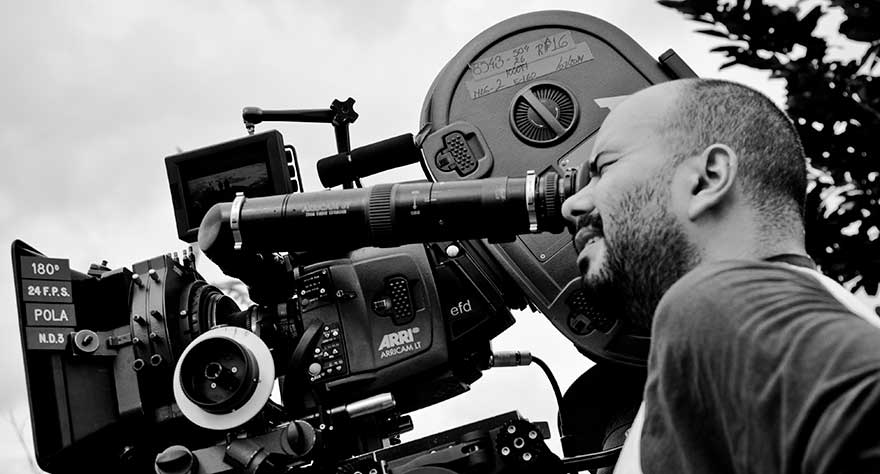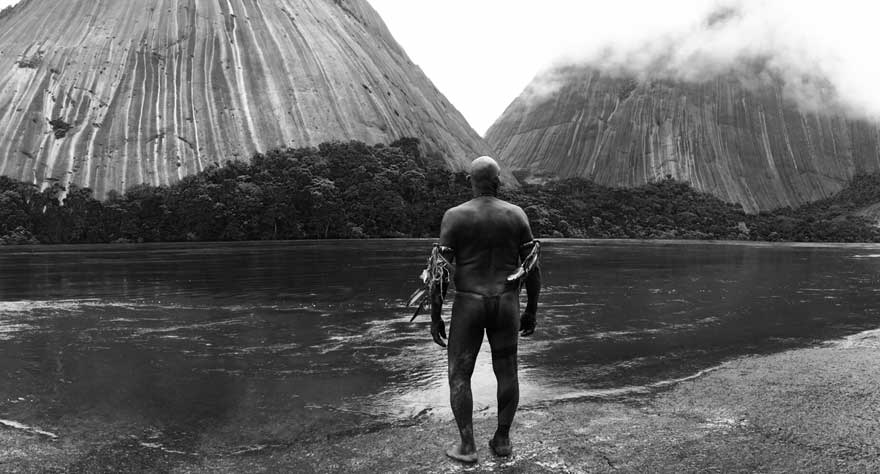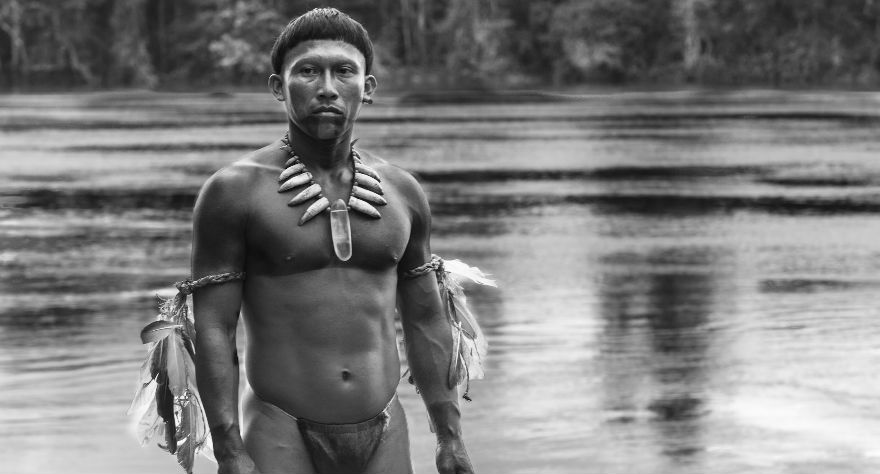Oscar Nominee Ciro Guerra on His Journey into the Amazon for ‘Embrace of the Serpent’

Since its premiere at Cannes in May 2015, Ciro Guerra’s Embrace of the Serpent has been stunning audiences all over the world with its tale of Karamakate, an Amazonian shaman who helps two different explorers over two periods of time as they hunt down a rare psychedelic plant. In order to provide an accurate portrait of the Amazon location and the early 20th century time period, Guerra and his crew ventured into the Colombian Amazon to work with the native tribes and bring their vision to life. And while the film has its fair share of stunning imagery—it was shot in black and white on 35mm film—Guerra doesn’t avoid confronting the horrors of colonization going on at the time, using his narrative to explore the devastating short-term and long-term effects of the West’s destruction of Amazonian cultures.
I talked with Ciro Guerra about Embrace of the Serpent last year at the Toronto International Film Festival, and since then the film has gone on to earn an Oscar nomination for Best Foreign Language Film. Read on for the full interview below, where Guerra talks about his intensive research process and what filmmaking means to him.
Embrace of the Serpent opens in New York City on February 17th before expanding to Los Angeles, Toronto and more cities on February 19th.
Tell me about your research process for this film.
It was about 3 and a half years of research during which the script was developed. The starting point was the journals of the explorers. I found them fascinating when I read them. I thought it was a great story that had not been told. I was fascinated by these men who left everything behind, who left their families and their lives to go three, four, even 17 years in the case of Schultes, to an unknown place and just tell the world about it. I first traveled to the Amazon region after reading them, and what I found was completely different. The region is completely transformed. So [the film] is part of a desire to bring back this Amazon to the way it used to be, and it was a big effort. People don’t dress like that anymore, and most of the traditions and languages are lost or in the process of disappearing.
We contacted the communities and we asked them if they want to be a part of the film. They said, “Our condition is that, in order to give you permission to shoot here, we are part of the film.” That made us very happy because we were able to collaborate. And for them, it was like bringing back the stories of their grandfathers or their ancestors they have heard from before. We wanted to bring an image of that to life because history has no image of that moment.
Were you initially nervous about approaching the communities in the Amazon?
I think the people of the Amazon are really open and friendly and enthusiastic. They are very joyous people. They can see through you, so if you’re transparent and you’re not carrying any second intentions they can see that immediately. But they ask you the really important questions, which are “What’s the real reason you want to make this film? What’s the true reason?” And for me, it meant going back and looking in the mirror and asking myself, “What is the reason I want to make this film?” When I understood that I wanted to learn and share the knowledge, I felt comfortable saying this is the reason. If the reason had been that I want to work, I want to go to a festival, win awards or make money, I should have quit at that moment.
How did you initially come upon the two journals that you based the film on?
I had a lifelong dream of making a film in the Amazon. I had come from making my first two films, which were personal and about my life, my memories, my childhood, and my culture. For this film I wanted to go the opposite way, to take a journey into the unknown. The Amazon is half of Colombia and it’s completely unknown to Colombians. It’s a place that we have very little knowledge of. I have a friend who’s an anthropologist, who was an actor in my previous film, who said if I want to go into the Amazon I should start with the journals of the explorers. I related heavily to [the journals] because, to me, making a film is like that. It’s a journey into something where you never know what’s going to happen. It’s uncharted territory every time you make a film. I related strongly to that quest and hunger for knowledge.

Your previous film Wind Journeys was shot in 80 locations, and with Embrace of the Serpent, you’re going to the Amazon to make it. You’re doing much more than other people might normally do when making a movie. Is this something you feel like you need to do in order to make a film?
I think films should be an experience, both making them and watching them. When you sit in the theatre in the dark you want to be taken somewhere. You want to be changed, you want to live an experience. For me, with the process of making a film, I like to tackle it that way. I want a film to take me somewhere, to change my point of view, to confront my ideas in life and the world. Filmmaking is a really intense experience, and I think it should be. It shouldn’t be an office job. It shouldn’t be predictable or safe. It should be risky. When there’s that excitement on your part, from the people making the film, the audience feels that.
What made you decide to shoot on 35mm?
The look of the film was inspired by the photographs that the explorers took. [They’re] almost daguerreotype kind of pictures, but they have an organic quality, and in order to have this organic quality there’s no match for film. I have no problem with high definition video. I think it’s right for urban stories, modern stories, and artificial light, but when you want to get the real texture of nature, film is the way to go. It’s not possible to think of something else. But it also gives you some limitations.
There are strengths with film. The cameras are more [like] battle cameras. Some of them were made to shoot wars, so they are good for shooting in rough terrain. They do better with humidity and external conditions while video cameras are not so tough with these environments. But there was also something else. Since we had to shoot on film, we had limited stock, so we only had two takes for each shot. With video, you can do 17 takes for one shot, but here it’s two takes, and that makes every take precious. It focuses the actors, the crew, everyone. When we used to take photographs on film, every photograph was valuable. We had to choose and take care of it. Today with the digital age, you take thousands of photographs but they have no value. You never look at them again. You don’t frame them. In film you’re making a leap of faith, and that’s fascinating.
Was it a very stressful shoot then?
I thought it was going to be. We were prepared for the worst, and it was a very demanding and tough shoot, but it wasn’t stressful. The choice that we made to be very respectful to the environment, to the communities, to make as little impact as possible, meant that we felt that the jungle was playing to our side. We felt a connection with each other and the place that we were in, so it became a very profound and spiritual experience for all of us. I feel that, when you try to bring a foreign shoot into a place like this and try to obey all the rules of the place, you can turn the place against you. But, in this case, I felt that we had the protection of the place and the spiritual support of the community, so it turned into a very happy experience for all of us.
Tell me about the way you developed Karamakate.
The interesting thing to me was not to make [something] usually seen in this kind of movie, where you have the main point of view from the explorer. It was very clear to me that to make this story unique I had to switch the point of view. There was a character in the journals who had a very small appearance and I found him fascinating, so I started developing on him. But I had to switch something in my mind in order to write him and create him. That took about 2 years of writing and researching to really understand how this character sees the world. Not only that, I also had to make it understandable for an audience. It’s a role that’s so foreign that it’s easy to get lost, and I was really lost for a while.
But then we found the actors. They were really a part of developing the character. They brought their own experience and their own views, and they enrichen the characters through dialogue and action. But I think we were safe because it was a fiction, so we had some liberties.

Do you feel that what these explorers were doing was vital, or did it just contribute further to the colonization going on at the time?
I feel that what they did was vital because, if those encounters didn’t take place, these cultures would have been erased by capitalism and we would have never noticed them. These encounters in the jungle had a really big impact because this knowledge that was liberated for the first time really changed the world during the middle of the 20th century. All of the first ecological movements were influenced by these journals. The writers of the Beat Generation were influenced. For example, Burroughs went to Colombia to see if this was all true. It had a big influence on what became psychedelia and the hippie movement, and also the change of consciousness that brings us today to a world where environmental issues are a thing. A hundred years ago it would be impossible to discuss these matters of preserving other cultures and other languages, or being respectful to these people who, at that time, were seen as primitive, subhuman and souls that needed to be rescued. I think that the journals of the explorers really helped change that.
What made you bring in the concept of the Chullachaqui myth?
During the [research] process, I came upon the Machiguenga myth of the Peruvian amazon. It struck me because I was exploring the German culture at the time, and there was a direct resonance with the myth of the doppelganger. But then it struck even harder because it’s an ancient myth that speaks to contemporary men. We’re living in an age where people are communicating through virtual avatars. It was something timeless that was contemporary as well. It also gave me an idea of how I could find a way to express the feelings of a character who feels that their culture is disappearing and about to be lost. I decided that it was going to be the driving myth behind the film’s structure.
When did you come up with the idea to link these journals together and use Karamakate as the connective tissue?
I was looking at a way we could bring the viewer into a different world or view. In the journals of Theodor Koch-Grunberg, the German explorer that I was inspired by, he came following the footsteps of another German explorer named Schomburgk, who had been there 40 years before. Koch-Grunberg reached a community on the border of Colombia and Venezuela. They welcomed him and, for that generation, he was the first white man they had ever seen. He spent two months there, and all the time they talked about the myth of Surumbukú. After a while, he realized that Surumbukú was Schomburgk. The other explorer became an Amazonian myth, and now he was also Surumbukú. He was the same. So he understood that, for them, there was only one man going back in time every time. He was one soul traveling through different men who are coming in search of knowledge. I thought that was brilliant, and I was excited by that. This was a really great way of telling a story in which time is not a linear thing, but a multiplicity of things, which is the way they see time.
